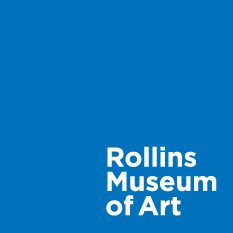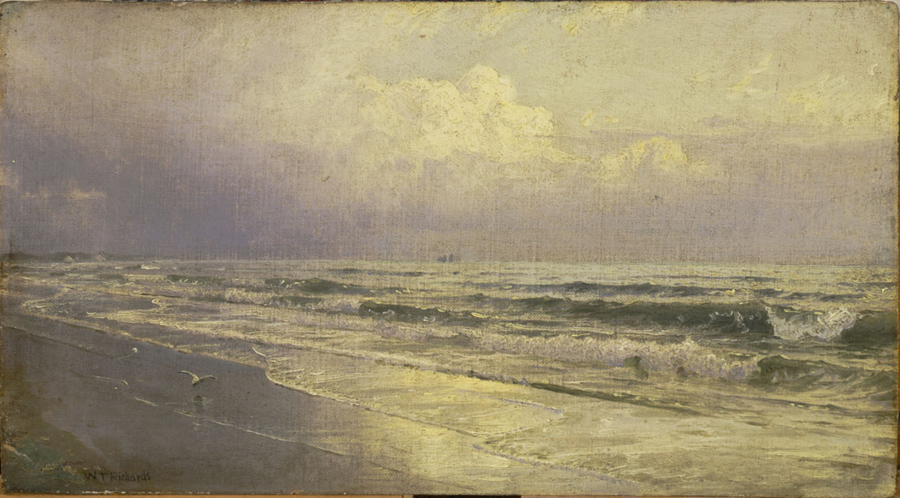In July you may have seen me deliver a Collections Conversations talk on one of my favorite objects in the collection, Shoshone Indians Rocky Mountains, an 1859 oil sketch by the American painter Albert Bierstadt. In it, I talked about my belief that it was made in preparation for Bierstadt’s first monumental landscape of the American West, Rocky Mountains, Lander’s Peak (1863, Metropolitan Museum of Art). I made this determination in part based on research I did as part of the project, but also for my dissertation, which was on Bierstadt and other American painters who lived and worked in Düsseldorf, Germany during the years before the Civil War.1 More than that, however, I used my sense of what Bierstadt’s finished oil paintings look like. His paintings, especially from this early period of his career, are highly finished, reflective of the rigorous training he received in Düsseldorf as well as the prevailing taste, which called for artists to make sketches in the field before returning to the studio to paint, often in the winter.2 They are also quite large, as much as ten feet on the longer, horizontal side. Shoshone Indians Rocky Mountains is neither, using looser and painterly strokes to fill in the basics of the scene. It is also quite small and would have been easy for Bierstadt to paint on from a small portable easel, or even perhaps from horseback.

Oil and gouache on paper mounted on board, 5 x 7 5/16 in.
Gift of Samuel B. and Marion W. Lawrence, 1991.9
I started writing this post not to rehash my dissertation or my talk from earlier this summer, however. Instead, I wanted to talk about another sketch in the collection, New Jersey Seascape – Atlantic City by William Trost Richards. Richards was of the same generation as Bierstadt—only three years younger—but his career took a rather different course, at least, as different a course as two landscape painters from the same time and place could. Richards came of age, like Bierstadt, in an era defined by the landscape painter Thomas Cole, whose untimely death in 1848 cemented his legacy as the dominant presence in American landscape painting for at least the following two decades. Richards, unlike Bierstadt, did not go to Germany to study (though he did visit Düsseldorf briefly), instead coming under the influence of John Ruskin, the English poet and art critic who preached close fidelity to nature in landscape art. Ruskin’s influence in the United States was profound and long-lasting, but its peak was relatively short, beginning in 1863 with the founding of the journal The New Path and ending about a decade later. Richards was one of the best-known and most successful painters working in this vein, turning out minutely observed landscapes of generally small, quiet spots on the Eastern Seaboard.3

ca. 1880-1890, Oil on canvas mounted on board, 9 1/4 x 16 1/2 in. (23.5 x 41.91 cm) painting
Gift of Samuel B. and Marion W. Lawrence in Honor of Joan Wavell,
former Director of the Cornell Fine Arts Museum, 1988.2
In the 1870s, however, tastes began to change, and Richards
began to turn to the sea, making a series of increasingly abstract watercolors
and oil paintings representing both the coast of the United States from Maine
to New Jersey and parts of England.4 He
loved the sea, and continued his practice of plein air sketching from
earlier in his career, though he found it difficult to do so under the wet,
windy conditions. He therefore commissioned a series of small devices—fashioned
from cigar boxes—that would allow him to paint in oil while standing on the
shore.5 New
Jersey Seascape – Atlantic City is like many oil sketches in that it is not
precisely dated, and we are not sure which—if any—of his finished paintings it
was in preparation for. Nevertheless, it is an absolute tour-de-force of the
medium, showing Richards in full command of both medium and subject. He
represents the cloudy sky, gently rolling sea, and a hint of the wet, barren
sand as three separate yet connected bands, blending almost imperceptibly
together in a slightly weak, golden light. A darkness on the horizon suggests
that a storm may be rolling in, or perhaps that the sun is rising just out of
view. Either way, Richards has mastered this liminal space where light and
dark, sea and land, all converge.
1 Grant Wesley Hamming, “Amerikanischer Malkasten: American Art and Düsseldorf” (Ph.D. Diss., Stanford University, 2016.For an overview of Bierstadt’s career see Nancy K. Anderson, Linda S. Ferber, and Helena Wright, Albert Bierstadt: Art & Enterprise, 1st ed (New York: Hudson Hills Press in association with the Brooklyn Museum, 1990).
2 For a landmark account of American landscape practice in the middle of the nineteenth century see Angela L Miller, The Empire of the Eye: Landscape Representation and American Cultural Politics, 1825-1875 (Ithaca: Cornell University Press, 1996).
3 Nancy K Anderson et al., The American Pre-Raphaelites: Radical Realists : [Exhibition, Washington, the National Gallery of Art, April 14 – July 21, 2019, 2019, 10-14. The New Path lasted only until 1865, but its ideas continued to be advanced, especially by the critic Clarence Cook, for some time after.
4 Iris & B. Gerald Cantor Center for Visual Arts at Stanford University, William Trost Richards, and Carol Margot Osborne, William Trost Richards: True to Nature : Drawings, Watercolors, and Oil Sketches at Stanford University (Stanford, CA; London: Iris & B. Gerald Cantor Center for Visual Arts at Stanford University ; in association with Philip Wilson Publishers, 2009), 40.
5 Iris & B. Gerald Cantor Center for Visual Arts at Stanford University, Richards, and Osborne, 94.

